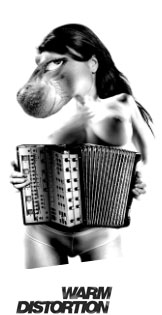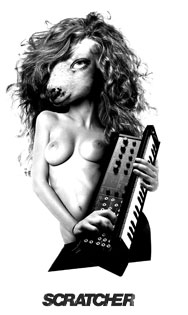For a good portion of the year The Locust are on on the road and when they're not melting faces, the members are spread out across seven hundred twenty six bands and forty eight record labels. Justin Pearson, the bassist, graciously gave some time out of his lax schedule to do a quick interview and share some pictures. Enjoy!
 Justin Pearson of The Locust
Justin Pearson of The Locust
Background
i was born in chicago and currently reside in san diego. i started "officially" making music/ sound about 17 years ago. i suppose what got me motivated was the obvious interest in music, bands, and the culture that was attached to certain genres of music and art. i use my legal name, justin pearson. ive been or are still part of the following bands: the locust, some girls, holy molar, head wound city, swing kids, crimson curse, ground unicorn horn, swing kids, struggle.
What is your current favorite piece of hardware?
im not sure what you mean by hardware. usually that word when in musical context is attached to a drum kit's hardware. i do play drums but im not that stoked on my set to where id have a favorite piece. so ill take this and apply it to my bass set up. and easily say that its my ampeg dan armstrong prototype bass. its a fav for the obvious. its what i use to create music. sure effects, amps and so on all help in creating sounds but its the bass that i use my hands with, and it has to fit in so many ways. its like a snipers favorite gun, a race car drivers favorite car, a dogs favorite ball.
What is your current favorite software or plugin?
i dont personally use software.
 How does your physical space and surroundings influence your workflow?
How does your physical space and surroundings influence your workflow?
i have worked in some of the most impractical rehearsal studios. either due to little physical space, or filthy slum lord style, or a bedroom. i do feel that i can write in any place as long as there is a good connection with whom im playing with. but the nicer and more practical the rehearsal space, im sure the easier it is to write. i guess i just have low standards.
Are you involved in any sound work like films or sound design?
no. i wish i was though.
What was the first piece of hardware you remember obtaining? The last?
first was when my moms cousin loaned me a gibson les paul when i was twelve. that was what actually planted the seed of creating music in my mind. last, is something by trogotronic. dont know the name of it as it was a one of a kind pedal.
 What is on your current 'wish list'?
What is on your current 'wish list'?
honestly, im pretty into what i have. but again, im intrigued by the stuff that nelson from trogotronic makes. the stuff he uses in bastard noise and geronimo is amazing. so if i had the money and time, id submerge myself into his realm of sound.
Do you have a setup for live performances?
all the gear i use is used for live performances. this would include 2 ampeg dan armstrong bass guitars, two ampeg svt bass heads, a 2 x 15" speaker cab, and a slew of effects pedals.
 How many physical locations have you had your studio?
How many physical locations have you had your studio?
im not quite sure. for some of the projects i was involved in i was just doing vocals so i had little to nothing with me. but as far as my bass set up, its traveled to many places over the years. i suppose they became a bit better over the years. or maybe not better but more specific to what i was doing and what i needed a studio for.
You can find some of Justin Pearson's projects here:
myspace.com/thelocust
myspace.com/headwoundcity
myspace.com/holymolar
myspace.com/groundunicornhorn























